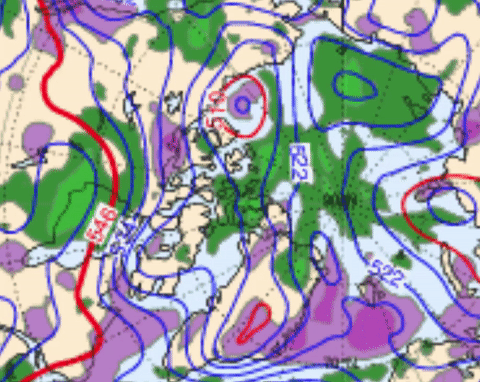We follow here the progression or regression of the first dominant Anticyclone to cover the Arctic Ocean. In the Past , Siberian cold continental air easily invaded and teamed up with the other side
of the world cold dark clear air massive buildups, the beginning of cold dark winter didn't take long to be felt by millions once they merged. Now we see first hand the further demise of early winter:
CMC Surface analysis November 25 18:00 UTC, November 26 00, 06 and 1200. With real cold air in Siberia, normal -45 C, but warmer every where else in the Arctic. Some North Atlantic Cyclones now repulsed towards and warming the Urals, this was the settled view for years starting in October. We now have a push block situation, the Pacific Cyclone is pushing Northwards, the latest North Atlantic Cyclone blocked and stalling towards Greenland.
For weeks, there was no wide spanning Highs over the Arctic Ocean. Now we can surmise the numerous leads amongst thinner sea ice finally freezing. I watch carefully how strong or enforced this North Pole High will be. The cold gathered in Siberian darkness wages the spread of winter from darker lands favoring radiation to space. In Northern Canada, the Pacific and Atlantic Cyclones continue the warmth initiated by the great sea ice dispersion event of early September just past. WD November 26,2016
Next day November 27 show a retreat of the High whence it came, back positioning because Cyclones have influenced the jet stream favoring their return to the Arctic Ocean, made easier by the warmth still present, the jet stream is bent along the Eastern Greenlandic line easing the return of North Atlantic Cyclones.WD November 28,2016
November 28 key Cyclone position Northeast Greenland is a slingshot for the next one to the South, North Pacific Cyclone conspires to do the same, the Siberian High is much thinned but still resisting the perimeter assault.WD November 29 2016
November 29 Push and Pull is in, the Cyclone NW of Canadian Archipelago coast has severely weakened the Siberian High, all while partner from the North Atlantic did the same. Not really apparent, the High pressure SE of Greenland has injected tremendous heat Northwards abetting
the push to destroy the Siberian Antiyclone. Again the Cyclones have hanged about Arctic Ocean locations which warmed the most over summer past. Coup de grace is about to finish the Siberian cold, the NW archipelago Low will pull in the Atlantic Low , soon the entire Arctic Ocean will be back to clouds and Low pressure warmth. WDNov30,2016

Gone, the once proud High pressure zone spanning the entirety of the Arctic Ocean vanished Day November 30. Ever present Arctic heat has encouraged warm air Advection not only from the seas, but from Northern Canada. This is quite unusual, even 2012 had no such event in Early December darkness. The temperatures of the entire Troposphere in 2012-13-14 -15 spanned much colder all over the long night. Americans and Canadians don't know yet how warm this winter is setting up to be. But they already have had a very warm start of winter, no sign of industrial planetary sized cold air production even in Eurasia. Every location is geo-meteorologically linked. Here again suggests warmest influence from the oceans. WD December1,2016

















































